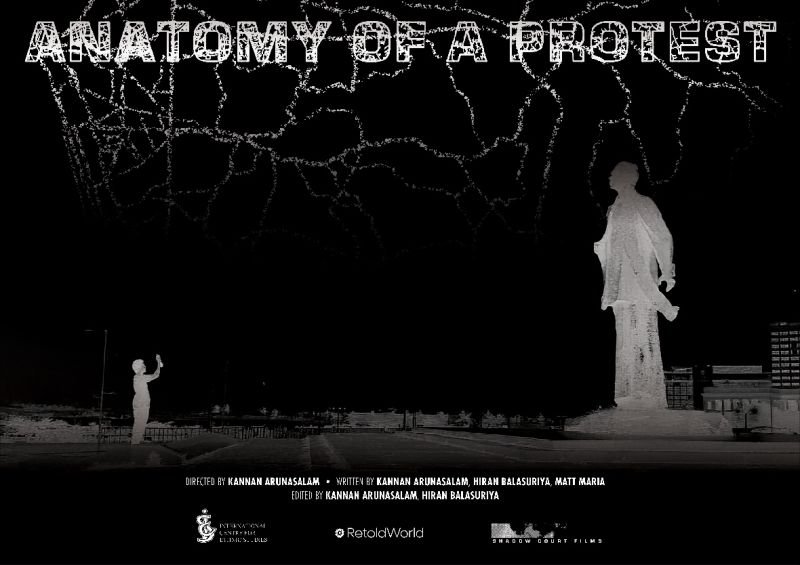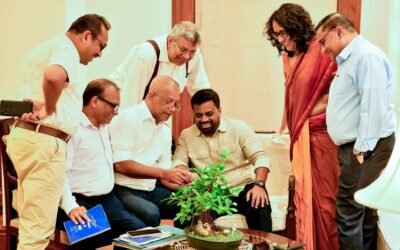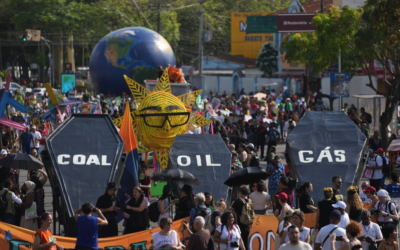Anatomy of a Protest and Aragalaya Cinema
Hiranyada Dewasiri
The 2022 people’s uprising and occupation movement in Sri Lanka, widely known as the Aragalaya, was heavily documented through film. This material has begun returning to the public in the form of documentary films. Kannan Arunasalam’s Anatomy of a Protest (2024) is one among them.[1]
People’s Voice is Louder (2023) that features Riyal Riffai, Lojithan Ram, Nayanahari Abeynayake, and Pirainila Krishnarajah; #GoHomeGota (2023) by Sulochana Peiris; and Cross of Justice (2023) by Anoma Rajakaruna, are some other documentaries. Prasanna Vithanage’s Paradise (2024), a feature film set against the same backdrop, began screening in Sri Lanka after this review was finalised. I will call these films ‘Aragalaya Cinema’, to understand their underpinnings.
For a public who participated in the Aragalaya in person and on an internet screen, watching a documentary is an extension or a continuation of this experience. In this context, all films made are an addition to this visual world. Documentary films engage with this infinite number of footage and stills, sort through them, and frame them in different ways. The choices that are made by filmmakers during this framing constitute an afterlife for the Aragalaya. However, it is important to contest and question some of these narrative choices, while acknowledging that the Aragalaya is not a singular story. In this piece, I raise some questions about the choices made in telling the story of the Aragalaya in Anatomy of a Protest.
Arunasalam’s film consists of a large compilation of visual material that was produced during the Aragalaya by its participants, juxtaposed with footage from prior political events of the country that adds context and builds narrative. It can be divided into two parts. One looks at the Rajapaksa family, their alleged crimes, and their downfall. At the same time, the film follows three young protestors who were tented at Gota Go Gama (GGG) – the main occupation site of the protest movement in Colombo. The film walks the audience through their initial participation in the protest, to their reflections some months after the occupation’s end.
In its first part, Arunasalam’s film captures the violence on the anti-Rajapaksa occupation/protest sites and the assault of protestors by the supporters of the Rajapaksa camp. To a public that has heard this story throughout 2022, and has rejected the Rajapaksa rule by producing the same visual material the film uses, this part of the film would feel like an extension of the 2022 social media discourse. However, the film recognises Sri Lanka’s violent past in setting the context for the Aragalaya. The filmmaker shows us the experiences of Tamils, the long fight for justice by the Mothers of the Disappeared, assassinations of journalists, Buddhist religious extremism, and economic violence aided and committed by the Rajapaksa regime.
Yet, the film’s engagement with violence is asymmetrical as the counter-violence experienced after the attack on GGG does not appear in the film. After their attack on GGG, Rajapaksa supporters were thrown into the Beira Lake, the buses they travelled in to Colombo were burnt, and the homes and properties of ruling party parliamentarians damaged, while Sri Lanka Podujana Peramuna MP Amarakeerthi Athukorala and his security officer were killed.
Apart from videos and a mention of then Prime Minister Ranil Wickremesinghe’s house being set on fire (which provides linearity to his presidential ascent), the film portrays the Aragalaya as peaceful. This is furthered by one of the protestors in the film affirming that this is a “non-violent struggle”. While ‘non-violent struggle’ refers to a strategy of protest, violence occurring within such movements shape their trajectories. The absence of one of the biggest events that took place during the Aragalaya takes away from the credibility of the film’s overall criticism of violence. The choice to make no mention of the violence that took place on the second half of 9 May and the couple of days that followed, warrants examination. This is especially important as another film that tells a beginning-to-end style story of the uprising, #GoHomeGota, skips this event.[2]
The Anatomy of Protest’s hyper-focus on the anti-Rajapaksa rhetoric also suggests that GGG was charged with strong liberal values. This paints a picture that oversimplifies the dynamics of coexistence within the space. As many groups involved in the movement were at odds with each other (e.g. Mullivaikkal commemoration vs disabled ex-military),[3] exploring the complexities of these dynamics would allow more critical engagement around the politics of the protest.
The other part of Arunasalam’s film is a study of three protestors. The film takes us to the ‘centre of the action’ with three participants, in an interesting study of the construction of a new brand of protestor. While Arunasalam’s selection of three anglophone middle class protestors from Colombo: Jeana de Zoysa, Buwaneka Perera, and Melani Gunathilaka, can be called a skewed selection of protagonists which may paint the Aragalaya as a middle class-led movement, it has allowed these class positions and their experience of the Aragalaya to be analysed.[4]
The protagonists share their journeys with us as they tell us how their worldviews shifted during the occupation movement. This gives the audience context to read their engagement, their vision, and their journey. Until 2022, the urban middle classes viewed street protests as a public disturbance mostly practiced by left-wing political parties and activists that wanted to inconvenience the public. News alerts of protests happening in central Colombo were always framed through the traffic blocks they created, instead of the reason for the protest. However, the 2022 people’s protest movement altered this common perception as it witnessed the involvement of Colombo’s middle class in street demonstrations.
Writer and critic Boopathy Nalin put his twist on the widely-known slogan of the Aragalaya: “You messed with the wrong generation”, appending “and class” at its end. Street demonstrations became the norm. This is where we see the emergence of the Aragalaya protestor. While this individual was targeted by the State and media discourse after the end of the occupation, the protestor was approved by the public during and, to an extent, after the Aragalaya.
This new protestor is constructed through performing activism for cameras, from the filmmaker’s to their own. Towards the end of the film, one protagonist, Jeana de Zoysa, reflects on a selfie video she filmed during the attack on GGG. As she runs, the audience can see her crying face. This shot cuts to de Zoysa’s interview post-Aragalaya as she reflects on this clip. She tells the camera that as she watched this video much later, she found her crying face to be funny, highlighting what she thought was the importance of finding humour in such moments in hindsight. “You’re going to be a very sad person if you can’t do that.”
This deconstruction of the protestor shows the audience a person outside of her activism; someone who is aware of her appearance and has feelings about it. On the other hand, it also points to individuality as opposed to the collective identity of the most identified protestor in Sri Lanka – the left-wing university student activist.
By following the three characters from the heart of the action, the film participates in creating these protestors. Anatomy of a Protest is an opportunity for the audience to engage with these dynamics of class within the Aragalaya. But the film also leaves a question to the audience as it concludes: that is whether, and if so how, this protestor could continue to exist beyond the Aragalaya. Formed within the public consensus built for and by the Aragalaya, a study of this construct and the future of this protestor is an important exercise in understanding contemporary forms of resistance.
As a final thought, I would like to engage with two ideas by Vidarshana Kannangara and Prabha Manuratne. Manuratne questions whether the attempts to tell stories of the Aragalaya in chronological forms are raising concerns around the choices made in exclusions and inclusions of perspectives and events in the films.[5] Chronological narratives are important ways of engaging with ephemeral events. In a context where the memory of the occupation site by the Presidential Secretariat has been physically erased, documentation of how and why it started, how it happened, and how it ended, is important.
However, to answer Manuratne’s question of whether there are other forms instead of chronology, Arunasalam’s film consists of an insightful moment. When Jeana de Zoysa comments on her crying face, she invites viewers to critically examine the visual records that were collected during it. Criticism directed at governments, leaders, and political structures that enable their continuation was the focal point of the resistance and uprising.
Kannangara’s proposal[6] that it is now time for a cinema that critiques the Aragalaya invites us to instead turn the camera on ourselves and our own role in that political moment. The collection of footage provides filmmakers and their audience the necessary tools for that self-reflection. The critical interrogation of the Aragalaya is a needed intervention if one is serious about any kind of post-Aragalaya politics. Films that tell stories from the Aragalaya with no such apparent self-reflection, while remaining important as records, fall short in making effective political contributions that may take the discussion forward.
Hiranyada Dewasiri is a researcher in Colombo, with a background in English studies.
Correction: The reviewer writes “… the film’s engagement with violence is asymmetrical as the counter-violence experienced after the [May 9 2022 attack on GotaGoGama-GGG] does not appear in the film”. The review comments that “[t]he absence of one of the biggest events that took place during the Aragalaya takes away from the credibility of the film’s overall criticism of violence”. We have since seen footage from the film where reference is made to violence directed against members and supporters of the government on May 9 and thereafter; and where one GGG activist disavows the counter-violence, making a direct appeal on his social media for it to end; and a text slate that reads: “Countrywide violence leaves nine dead and about 300 injured”. The error is regretted. There was no intention to impugn the credibility of the film nor anyone associated with it. ~ The Editors.
Notes
[1] I watched the film in March 2024 at a feedback screening held in Colombo. It is important to note this, as the film is being edited for other audiences, and the filmmaker says he is open to reworking it, including changing its title.
[2] During the post-screening discussion of #GoHomeGota at the Goethe-Institut, Colombo, on 9 April 2024, Sulochana Peiris explained that she left this event out of her film because it was not established as to who was behind the violence. Although it is outside the scope of this review, a further examination of the ways in which the counter-violence of 9 May shows up (or does not) in representations or retellings of these stories needs doing in future.
[3] Having frequented the space of the Aragalaya, I have personally heard protestors playing songs on the heroism of the Sri Lanka Tri-Forces during the war with the Liberation Tigers of Tamil Eelam (LTTE), and making homophobic and transphobic slurs on megaphones.
[4] The filmmaker has reportedly said during a discussion that critiquing this classed experience was his intention.
[5] Discussion after the screening of #GoHomeGota and Cross of Justice at the Goethe-Institut, Colombo, 9 April 2024.
[6] Discussion after the screening of Anatomy of a Protest at the Bandaranaike Centre for International Studies, Colombo, 21 March 2024.
You May Also Like…
Dying for the Target
Ishankha Singha Arachchi
The harsh working conditions faced by workers in the pursuit of ever-intensifying production targets have long been a...
One Year On: Reading the NPP “From Below and to the Left”
Janaka Biyanwila
The National People’s Power (NPP) in Sri Lanka achieved a significant two-thirds parliamentary majority in the...
Declaration of the Peoples’ Summit towards COP30
Peoples’ Summit
16.11.25 - Belém (Brazil) We, the Peoples’ Summit, gathered in Belém do Pará, in the Brazilian Amazon, from 12 to 16...




